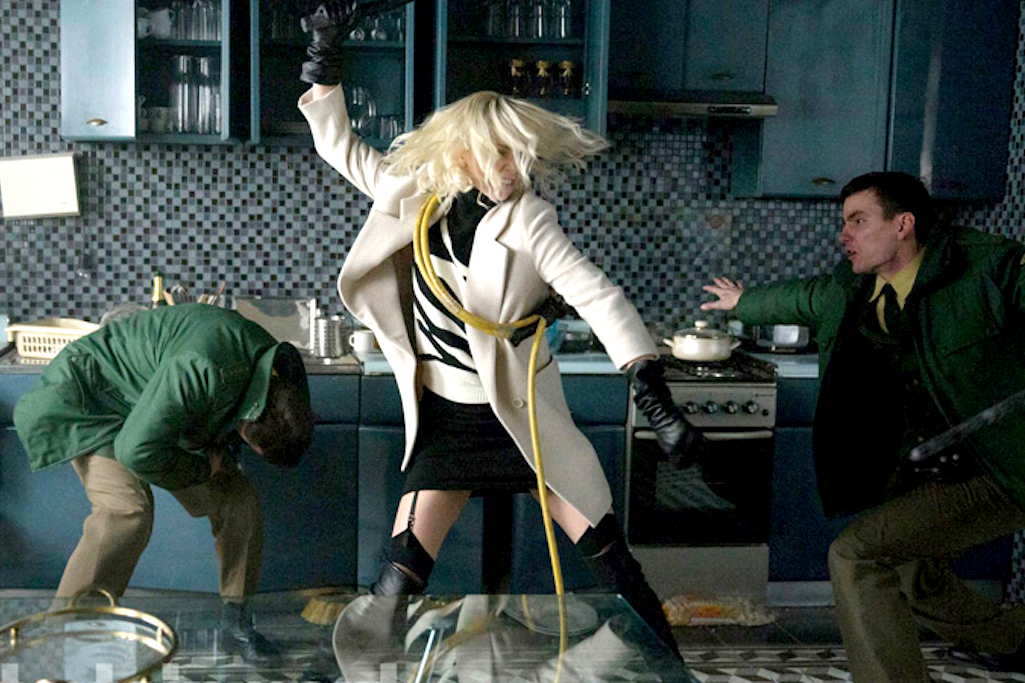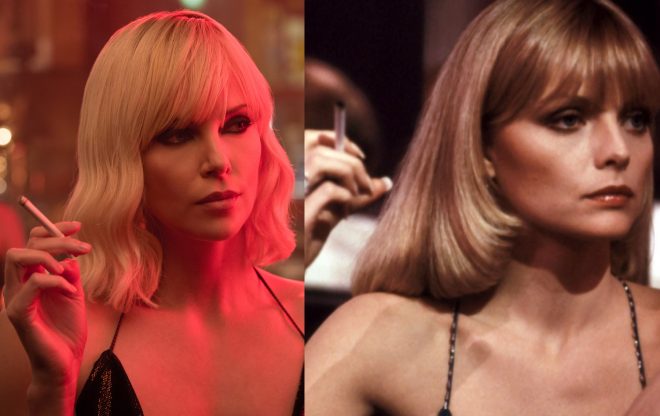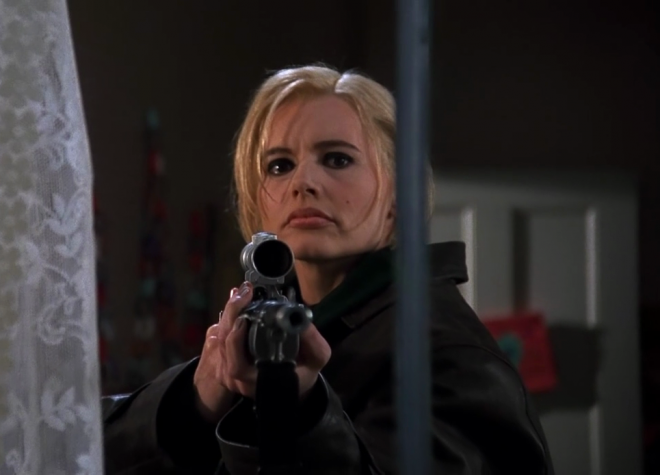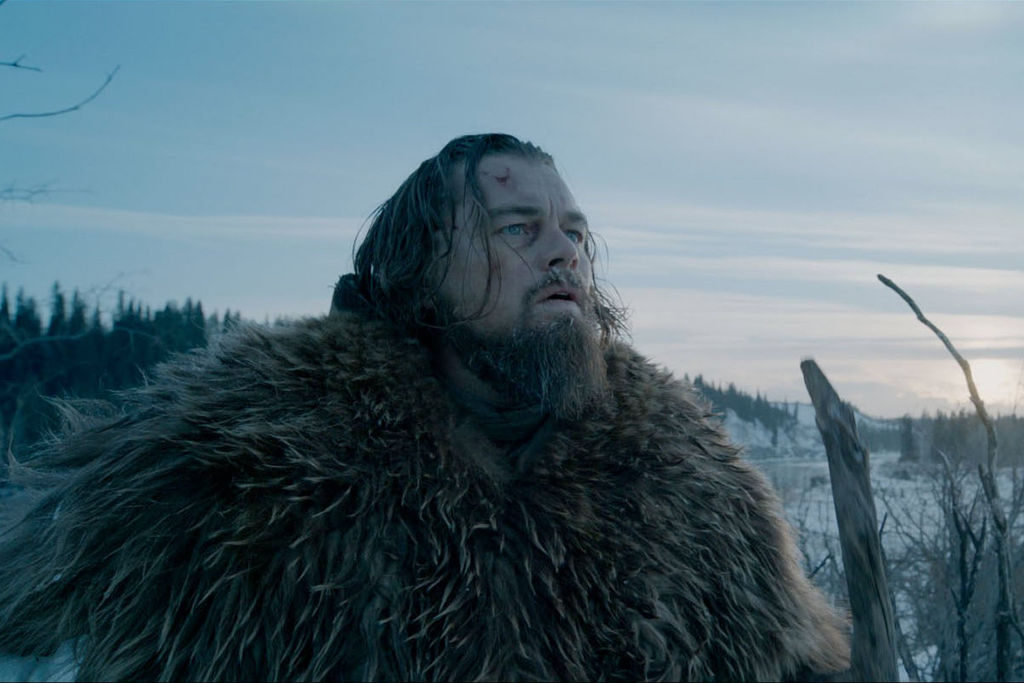‘Atomic Blonde’ Is A Powerful Survivalist Fantasy For Women
Charlize Theron redefines what it means to be a badass.

When I saw Atomic Blonde I’d just finished reading The Revenant by Michael Punke — the book that inspired the Leonardo DiCaprio film.
The Revenant is one of those semi-legendary frontier stories that shaped America’s idea of itself — rugged, self-sufficient, resourceful, and above all, masculine. The film sits alongside others like Into the Wild and the forthcoming Jungle and The Lost City of Z — stories that show the fantasy of testing oneself against an inhospitable landscape is still dangerously seductive for men.
But what about women? Our inhospitable landscapes are right here: we risk violence in our homes, streets, university campuses, public transport and workplaces. Our assailants can be people we know, and the institutions we trust can fail to protect us. What, then, are women’s survivalist fantasies?
Atomic Blonde is powerful because its protagonist, British spy Lorraine Broughton (Charlize Theron), is hyper-competent yet vulnerable. Yes, she’s coolly composed, and glamorously dressed; she outwits and outfights her opponents, and improvises with the resources at hand, all to an ’80s soundtrack as enjoyably arch as Baby Driver’s. But even as Atomic Blonde indulges in stylised spy-movie imagery, Lorraine doesn’t just shrug off the violence she faces. She puts her body on the line and survives, magnificently.
The Consequences Of Violence
Based on a 2012 graphic novel called The Coldest City, Atomic Blonde is set in Cold War Berlin, just before the Wall comes down in November 1989. Lorraine is being interrogated by her MI6 handler Eric Gray (Toby Jones) and CIA agent Emmett Kurzfeld (John Goodman) about a mission that went badly wrong.
Ten days earlier, she’d been dispatched to Berlin to retrieve a microfilm hidden in a watch, and identify and neutralise ‘Satchel’, a double agent who’d betrayed Lorraine’s former lover James Gascoigne (Sam Hargrave).
The film unfolds in flashback as Lorraine debriefs her superiors on how she liaised with MI6 Berlin station chief David Percival (James McAvoy), recruited a local assistant, Merkel (Bill Skarsgård), faced off with Soviet arms dealer Aleksander Bremovych (Roland Møller), and discovered a valuable Stasi defector codenamed Spyglass (Eddie Marsan). And she also made contact — so much contact — with a French agent, Delphine Lasalle (Sofia Boutella).

This isn’t Tinker, Tailor, Soldier, Spy. The plot is basically an excuse to place Lorraine in various urban spaces within East and West Berlin for a series of face-offs and ultraviolent combat scenes. It’s director David Leitch’s first solo feature, but he has an impeccable action pedigree: he’s been a stunt double for Brad Pitt and Jean-Claude Van Damme, and he co-directed the first John Wick film.
Having established her action credentials in Mad Max: Fury Road, Theron does almost all her own stunts. And in a genre that frequently obscures the shapes of stunt choreography with lightning-quick cuts and shaky-cam, it’s striking how long and wide Leitch’s takes are during hand-to-hand combat scenes. It’s exhilarating to see Lorraine deliver vicious punches and kicks, using nearby objects to inflict damage.
Leitch lingers on the effects of blows and falls on a woman’s body – but never to position her as a victimised object. Lorraine is introduced naked and badly bruised, emerging from an ice bath like a recovering athlete or fighter. And when she’s knocked down, it’s incredibly satisfying to see her get up again and again, visibly pushing against physical limitations of pain and fatigue.
Glamour And Grit
Over and over, Atomic Blonde depicts Lorraine strutting through streets and bars like a supermodel, wearing a succession of amazing winter coats, sunglasses, boots and turtleneck jumpers. “If I knew he was going to call the police, I would have worn a different outfit,” she deadpans to her bosses.
Unlike her colleague, David — whose Romper Stomper-esque shaved head, shearling jacket and knitted vests help him mingle with the East Berlin counterculture — Lorraine isn’t dressing to blend in. Clothes are Lorraine’s professional armour: a visible sign of her ruthless hyper-competence.
Lorraine’s largely monochrome, minimalist outfits – brilliantly realised by costume designer Cindy Evans – take inspiration from Helmut Newton’s chic, luxuriously sexual black-and-white fashion photography of the ‘80s, and Buffalo style: the tough, androgynous London club look popularised by stylist Ray Petri in magazines such as The Face. The spangled halter-neck jumpsuit Lorraine wears to meet the gangster Bremovych is surely a homage to Michelle Pfeiffer in Scarface (1983).

It’s great to see a woman’s clothing depicted onscreen as a source of her own capability and pleasure, not as decoration or fetish. We see Lorraine’s gartered stockings when she kicks a man’s legs out from under him, or as Delphine reaches for her. We see her underwear as she tapes a recording device to her body. We see her stab a henchman with her stiletto heel.
Lorraine’s dark-shadowed eyes under a platinum-blonde fringe recall Furiosa’s oil-smudged war paint. But they also reminded me of Geena Davis’s intensely feminine makeover from amnesiac schoolteacher Samantha to ice-blonde assassin Charley in The Long Kiss Goodnight (1996).
Later in the film, when a hitman later tries to lure Charley into an alley, she replies contemptuously, “No thanks, I’m saving myself ’til I get raped,” before casually gunning down the hitman and several of his colleagues.

Cool Girls Don’t Look At Emotions
Badassery is the dominant tone of action movies. It’s an intensely masculine attitude: a cocky disregard for authority, safety and vulnerability. As The Lonely Island put it, cool guys don’t look at explosions. Or, as Samuel L. Jackson puts it in xXx: The Return of Xander Cage: “Kick some ass, and try to look dope while you doin’ it.”
Women can definitely be badasses. Just look at Angelina Jolie in the underrated Salt (2010), which, like Alien, was originally written for a male protagonist. But Atomic Blonde shows that macho posturing is fucking wearying. Sure, an impassive, hyper-competent heroine is fun to watch. But Theron’s almost unsmiling performance highlights the effort required to sustain badass posturing, and the loneliness of a career spent crushing down human emotions and instinctive responses.
Badassery is the action-movie expression of a broader sexism in which women are coded as ‘cool’ or ‘chill’ for tolerating men’s bullshit, and derided as ‘hysterical’ or ‘irrational’ for accessing and revealing their inner selves. So many action heroines are portrayed as humourless, sardonic or irreparably traumatised by their intensive training that Wonder Woman’s earnest humanism felt excitingly fresh and hopeful.
Atomic Blonde isn’t a superhero fantasy, but Lorraine’s power is that she retains a capacity for humanity despite her training, and she feels emotions without letting them distract from her mission. She quietly mourns her dead lover, Gascoigne, and her steamy dalliance with Delphine is an interlude of tenderness in her harsh life. Leitch has said that Lorraine “will find her intimacies and her friendships in small doses, with anyone she can… You sort of find comfort where you get it.”
Seeing two women just being with each other feels revolutionary in a mainstream action film. Spy films like Kingsman: The Secret Service — in which Boutella was so great as henchwoman Gazelle — often leave me, a female viewer, feeling weary and excluded. Their fantasies aren’t meant for me; but Atomic Blonde’s fantasies of female survival are. When Delphine points out that she can tell when Lorraine’s telling the truth, the seasoned agent replies ruefully that letting her guard down will get her killed one day. “But not today.”
–
Atomic Blonde is in cinemas now.
–
Mel Campbell is a freelance journalist and cultural critic. She tweets at @incrediblemelk.

